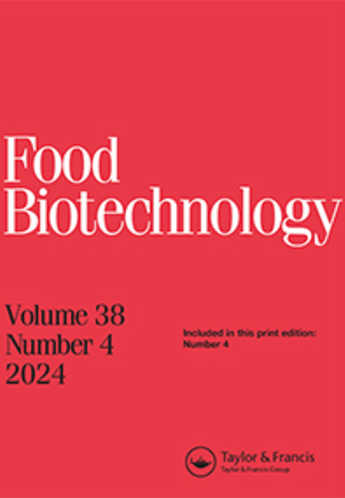Probiotic and Cyanide Degrading Potentials of Pediococcus Pentosaceus and Pichia Exigua Isolated from Cassava Products Effluent
IF 1.6
4区 农林科学
Q4 BIOTECHNOLOGY & APPLIED MICROBIOLOGY
引用次数: 0
Abstract
ABSTRACT Cassava tubers contain high levels of cyanogenic glucosides that are toxic when consumed. Lactic acid bacteria and yeast from the effluent generated during the processing of cassava products were assessed for cyanide degradation and probiotic potentials. Pediococcus sp. OG08 and Pichia sp. OG4 had higher bile salt tolerance (p < 0.05) in 0.3 % bile salts (82.5 %,77.7 %) and 0.5 % bile salts (69.3 %, 71.2 %) respectively. They displayed high potassium cyanide tolerance (Pediococcus sp. OG08, 45.7 % and Pichia sp. OG4, 44.7 %). Pediococcus pentosaceus OG08 and Pichia exigua OG4 resulted in the lowest residual cyanide content of 2.75 and 2.80 mg/kg respectively. The unfermented cassava flour had a residual cyanide content of 19.78 mg/kg. Pediococcus pentosaceus OG08 and Pichia exigua OG4 passed safety assessments, were valuable as probiotics due to their beneficial attributes. Cassava effluent possess valuable resource for potential probiotics.木薯制品废水中戊糖球菌和毕赤酵母的益生菌和氰化物降解潜力
摘要木薯块茎含有高水平的发蓝葡萄糖苷,食用后有毒。对木薯产品加工过程中产生的废水中的乳酸菌和酵母的氰化物降解和益生菌潜力进行了评估。Pediococcus sp.OG08和Pichia sp.OG4在0.3%胆汁盐(82.5%,77.7%)和0.5%胆汁盐(69.3%,71.2%)中具有较高的胆汁盐耐受性(p<0.05)。它们表现出高的氰化钾耐受性(Pediococcus sp.OG08,45.7%和Pichia sp.OG4,44.7%)。戊糖球菌OG08和毕赤酵母OG4的残留氰化物含量最低,分别为2.75和2.80mg/kg。未发酵的木薯粉的残余氰化物含量为19.78mg/kg。戊糖球菌OG08和毕赤酵母OG4通过了安全性评估,由于其有益的特性,作为益生菌是有价值的。木薯废水为潜在的益生菌提供了宝贵的资源。
本文章由计算机程序翻译,如有差异,请以英文原文为准。
求助全文
约1分钟内获得全文
求助全文
来源期刊

Food Biotechnology
工程技术-生物工程与应用微生物
CiteScore
3.80
自引率
0.00%
发文量
15
审稿时长
>12 weeks
期刊介绍:
Food Biotechnology is an international, peer-reviewed journal that is focused on current and emerging developments and applications of modern genetics, enzymatic, metabolic and systems-based biochemical processes in food and food-related biological systems. The goal is to help produce and improve foods, food ingredients, and functional foods at the processing stage and beyond agricultural production.
Other areas of strong interest are microbial and fermentation-based metabolic processing to improve foods, food microbiomes for health, metabolic basis for food ingredients with health benefits, molecular and metabolic approaches to functional foods, and biochemical processes for food waste remediation. In addition, articles addressing the topics of modern molecular, metabolic and biochemical approaches to improving food safety and quality are also published.
Researchers in agriculture, food science and nutrition, including food and biotechnology consultants around the world will benefit from the research published in Food Biotechnology. The published research and reviews can be utilized to further educational and research programs and may also be applied to food quality and value added processing challenges, which are continuously evolving and expanding based upon the peer reviewed research conducted and published in the journal.
 求助内容:
求助内容: 应助结果提醒方式:
应助结果提醒方式:


